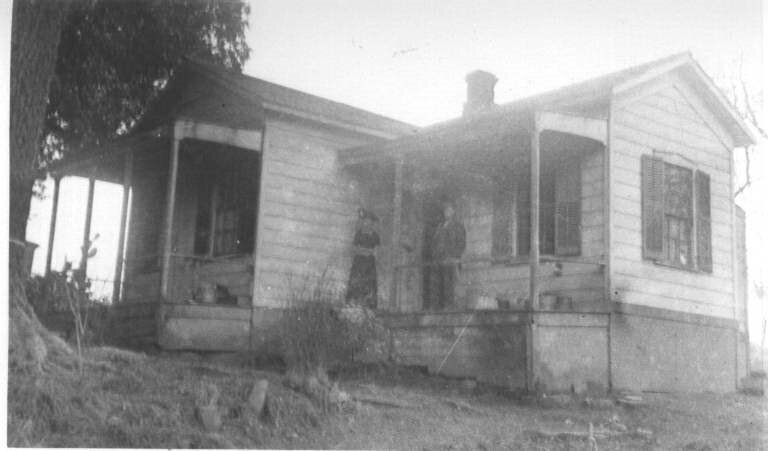Agapius Honcharenko: Priest, Printer, Activist, and Farmer
Written by HAHS Staff | Download a PDF of this article
If you have visited Garin Park in Hayward, perhaps you have come across state landmark 1025, better known as “Ukraina”. The site marks the farmstead and burial site of Agapius Honcharenko and his wife, Albina. But who were they? And how did he come to live in Hayward?
Agapius Honcharenko was born in 1832 in Kiev, Ukraine, at the time considered part of Czarist Russia. Little is known about his early life. By 1853, he graduated from the Orthodox seminary in the city of Kiev. He then entered the Kiev Monastery of the Caves, a historic Orthodox Christian monastery dating back to the 11th century. Honcharenko was sent to Athens in 1857 to serve as deacon of the embassy's church. While in Athens, he began to write and publish anonymous articles that clamored for the emancipation of Russian serfs and denounced his own Orthodox church for supporting such an unequal system.
Honcharenko was especially critical of Russia’s Czarist government. Word of his dissent reached Russia, where it was not taken lightly. After months of trying to determine the identity of the mystery writer, Russian authorities discovered and arrested him in 1860, holding him in a Russian prison in Constantinople. With the help of friends and sympathizers, he was able to escape to London, England. From this point on, Honcharenko spent the rest of his life in exile for his political views. For the next five years he travelled extensively in Europe, spending time in London, Syria, Jerusalem, Egypt and Turkey.
In 1865, Honcharenko immigrated to the United States. On his arrival, he spent some time in Philadelphia, where he met the woman who would become his wife, Albina, an educator and activist in her own right. In New York City, he established the first Orthodox liturgy in the U.S. outside of Alaska. He also helped establish a Greek Orthodox church in New Orleans and did work in Alaska before finally settling in San Francisco.
From 1868 to 1872, Honcharenko lived in San Francisco and published a Ukrainian and Russian language newspaper called the Alaska Herald. San Francisco at the time was a key center of distribution and communication for people living in Alaska, many of whom were Russian speakers. The territory of Alaska had been purchased from Russia by the United States only a few years after Honcharenko arrived in San Francisco. Some of the Alaska Herald’s earliest publications included a Russian translation of the United States Constitution and other official government documents. Honcharenko also wrote several editorials for the paper, denouncing what he saw as the abuses of power by the Russian government.
Agapius Honcharenko standing near the cave in the Hayward Hills he would hold services in, c.1900
In 1872, in need of money, Honcharenko sold his printing press to another publisher and made plans to relocate. In July 1873, Honcharenko and Albina moved to the Hayward hills, onto 80 acres of land they had purchased for 700 dollars. They named their farm “Ukraina” after Honcharenko’s homeland.
On their farm, they built a three-room cottage and began successfully farming the land. For a full-time political activist, Honcharenko was also a brilliant agriculturalist. He and his wife sent numerous samples of plants and vegetables to the editors of the publication California Horticulturalist. The editors thanked Honcharenko for a “monster squash”, a “gigantic sunflower” and “some of the finest sugar table corn and nutmeg melons we have ever tasted”. An early Alameda County history also notes Honcharenko’s experiments in growing imported mushrooms.
The home of Honcharenko and Albina in what is today Garin Park, c.1915
Honcharenko seated with visitors near his home, c.1910.
Within a short time, Honcharenko and Albina became key members of the Hayward community. On his farm, within a natural cave, Honcharenko led weekly Orthodox church services. Over time, he baptized over 100 people—including the daughter of longtime Hayward pharmacist R. Reid. He corresponded with a young local boy, Otis H. Webb, to whom he sent a “White Hubbard Squash” as a token of friendship. Meanwhile Albina held classes for the few children also living in the hills with their families. While their farm was self-sufficient, many longtime residents recalled seeing Honcharenko come to downtown Hayward to visit the post office or purchase supplies.
As Honcharenko’s popularity grew, local photographers sought a picture of the man dressed in his orthodox robes with his long white beard—an image that earned him the nickname “Santa Claus” with many local children. Local newspapers reported he spoke more than a dozen languages and embellished Honcharenko’s past in sensationalized tales—some more correct than others. This romanticized biography endeared him to local residents. In many ways, Honcharenko was a local celebrity, happy to share his story with the community that had welcomed him so warmly.
Honcharenko and his wife Albina, c. 1910.
For all the attention he received, Honcharenko remained a generous and thoughtful man. After the 1906 San Francisco earthquake, he and his wife opened their home to any refugees looking for a place to stay. Honcharenko and Albina lived simply and remained in the same three-room cottage for almost 43 years. In his old age, Honcharenko was cared for and looked after by his neighbors. When he was unable to pay the mortgage on his farm, local residents led by R. Reid came together to secure a lifetime lease of the property so he could remain in his home—a testament to the respect and esteem felt for him by his Hayward neighbors.
Early in 1915, Albina passed away. Honcharenko buried her not too far from the cottage they had shared for more than four decades. As he buried his wife, Honcharenko dug a grave next to Albina’s and asked to be buried next to her under the same tree. Just over a year later, on May 5, 1916, Agapius Honcharenko got his wish. His body was discovered by neighboring ranchers who stopped by to check in on him. He was quickly buried next to Albina. The farm was soon foreclosed on and sold. Their home and farm quickly fell into disrepair, and only the foundations remain today. The memory of the kind priest and his wife, however, live on for the residents who had come to know them.
The gravesite of Agapius and Albina Honcharenko in the Hayward Hills, c. 1916. The site is marked today as State Historic Landmark 1025.
Honcharenko on his front porch shortly before his death, c.1915.






